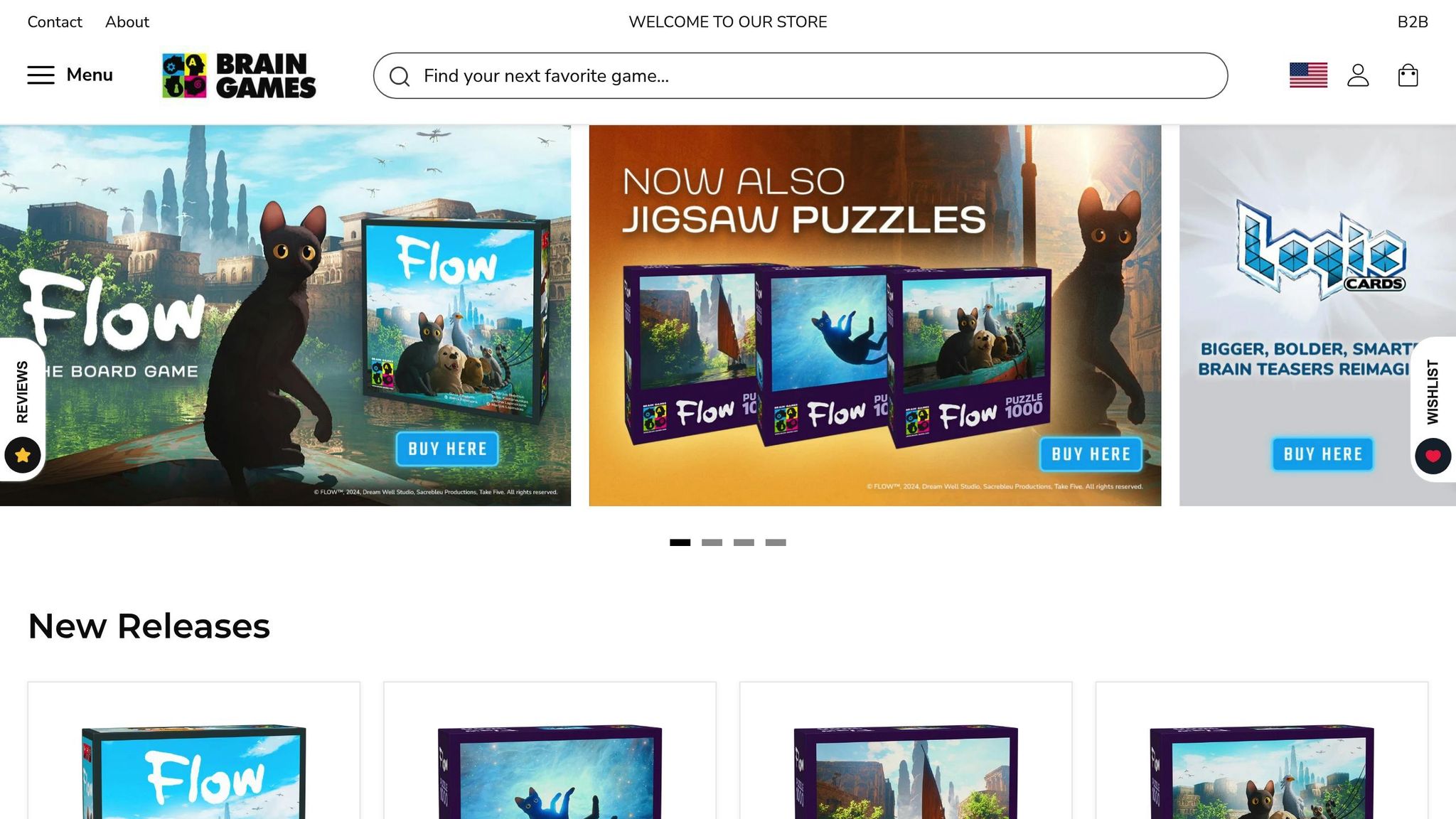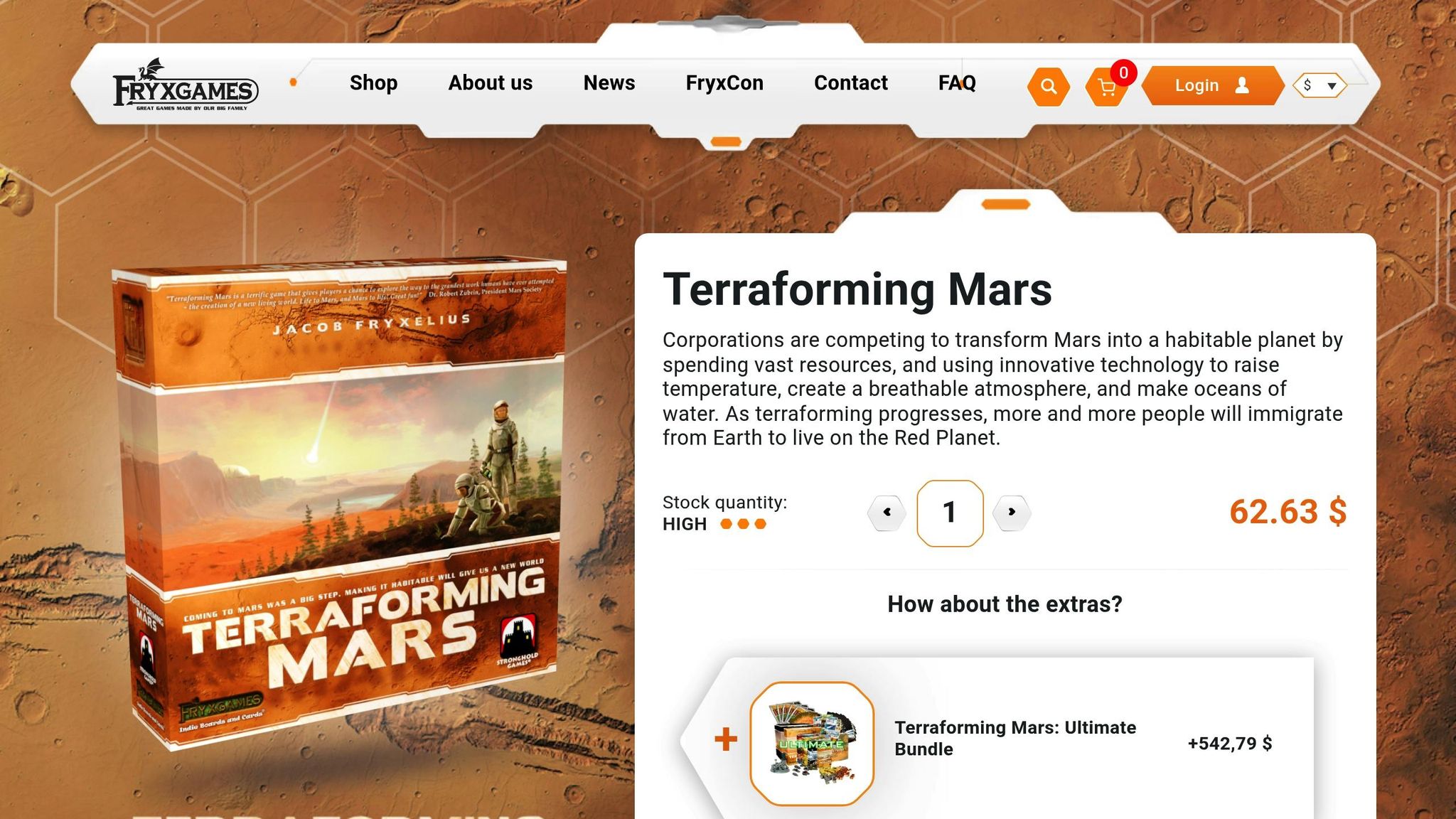Discover the Best Board Games for Every Player

Strategic Triumphs: Plan Your Way to Victory with These Hits
Looking to challenge your mind and enjoy some fun? These seven board games offer a mix of tactical thinking, planning, and player interaction. Whether you're a beginner or an experienced player, there's something for everyone. Here's a quick overview:
- Ice Cool: A fun flicking game with penguin-shaped pieces, great for families and casual play ($29.99 USD).
- Game of Trains: A card game where you organize train cars while disrupting opponents' plans.
- Catan: Build settlements, trade resources, and compete for 10 victory points in this classic.
- Ticket to Ride: Collect train cards and claim routes to complete destination tickets.
- Carcassonne: Place tiles to build roads, cities, and fields while managing limited meeples.
- Pandemic: A cooperative game where players work together to stop global outbreaks.
- Terraforming Mars: A deep engine-building game where you transform Mars into a livable planet.
Each game offers unique mechanics like resource management, tile placement, or cooperative play. Whether you prefer quick, light games or deeper, more complex challenges, these titles deliver hours of engaging gameplay. Check out Brain-Games.com or Brain-Games.lv/en/ to explore these and more.
The VERY BEST Strategy Games – What makes a game TRULY strategic?
Core Game Mechanics for Tactical Play
Strategic board games rely on a variety of mechanics to create layers of engaging tactical decisions. These mechanics form the foundation of gameplay, offering depth that rewards careful planning and sharp decision-making. Together, they shape the diverse experiences players encounter on the board.
One of the cornerstones of strategy games is resource management. Here, players gather and allocate limited resources like wood, stone, or currency. Every choice matters - spending resources on one action means sacrificing opportunities elsewhere. This constant balancing act ensures that every decision carries weight.
Another key mechanic is area control, where players compete to claim and defend territories on the board. Success hinges on expanding at the right time while blocking opponents from securing valuable spaces. This mechanic introduces direct competition, with players jockeying for position and engaging in territorial battles that keep the tension high.
Adding to the complexity, hand management challenges players to make the most of a limited set of cards or actions. The dilemma often lies in whether to play a powerful card immediately or hold onto it for a better opportunity. This mechanic rewards players who can think ahead and time their moves effectively.
With worker placement, each player has a limited number of workers to assign to specific actions. Once a worker is placed, that action becomes unavailable to others until the next round. This creates a competitive scramble for the most valuable actions, adding urgency to every decision.
Tile placement mechanics bring a dynamic element to the game board itself. Players place tiles to build roads, cities, or landscapes, shaping the board as they play. Each placement affects future opportunities, rewarding players who can plan spatially and anticipate how the board will evolve.
In deck building, players start with identical basic decks and improve them by purchasing stronger cards throughout the game. The challenge lies in balancing the acquisition of new cards with the effective use of the current deck, creating a satisfying sense of progression.
Engine building mechanics allow players to develop systems that become more efficient over time, generating resources or actions at increasing levels. Investing in an engine early can pay off significantly later, but it often comes at the cost of short-term gains. This mechanic is all about patience and long-term strategy, with exciting payoffs when the engine starts to hum.
Many games combine these mechanics, weaving them together to create intricate systems where every decision matters. For example, a game might mix resource management with area control or blend hand management with worker placement. The interplay of these mechanics ensures that players must adapt, strategize, and think several steps ahead.
1. Ice Cool

Ice Cool brings a fresh twist to board gaming by combining physical skill with strategic thinking. Published by Brain Games, this award-winning game has captivated players worldwide, selling over 500,000 copies to date. It challenges players to flick penguin-shaped pieces through a cleverly designed modular school layout, creating a game that's as fun to play as it is unique.
The game’s design integrates its box into the play area, forming interconnected rooms with doorways that players must navigate. Each round, one player becomes the Hall Monitor, tasked with chasing the Runners, who are trying to collect fish tokens while avoiding capture. This alternating role system keeps the 30-minute gameplay fresh and engaging.
Core Mechanics
At the heart of Ice Cool lies its signature flicking mechanic. Players must skillfully flick their penguin pieces across the board, which changes configuration with each game. This mechanic tests physical precision and spatial awareness while demanding quick strategic adjustments as the layout shifts. Rotating roles between Hall Monitor and Runner ensures every player gets a taste of both the thrill of pursuit and the challenge of evasion.
Layers of Strategy
While the game is accessible for kids as young as six, it offers surprising depth for more seasoned players. Runners must carefully plan their routes to collect fish tokens while staying out of the Hall Monitor's reach. Advanced techniques, like curve shots for tight corners or jump shots to leap over walls, add a layer of skillful strategy. The game becomes a balance of risk versus reward, where reading opponents' moves and predicting their strategies play a vital role.
Interactive Gameplay
The pursuit dynamic keeps players on edge, but what truly elevates Ice Cool is the interaction between players. Bluffing, misdirection, and even occasional alliances bring a social dimension to the game. This constant back-and-forth not only adds tension but also makes it a hit at family gatherings and parties, where laughter and friendly competition abound.
Endless Replayability
The modular board design ensures that no two games are ever alike. Each new setup forces players to rethink their strategies, while the unpredictability of the flicking mechanic keeps gameplay exciting. This replayability is one of the reasons Ice Cool boasts a 4.7/5 rating on Amazon from over 2,000 reviews. Priced at $29.99 USD and crowned with the 2017 Kinderspiel des Jahres award, the game combines skill, strategy, and variety in a way that keeps players coming back for more. It’s a perfect example of how a simple concept can deliver endless fun.
2. Brain Games' Game of Trains

Brain Games' Game of Trains takes the seemingly simple task of organizing train cars and turns it into a strategic showdown packed with timing and clever tactics. In this card game, players must arrange their railcar cards in numerical order while throwing a wrench into their opponents' plans. The result? A fast-moving, dynamic game where personal strategy meets tactical disruption.
Core Mechanics
The gameplay revolves around managing railcar cards to create a perfect numerical sequence. Players can take one of four main actions during their turn: replace cards to improve their sequence, remove troublesome cards, swap positions to refine their lineup, or shield critical cards from interference. The game incorporates Open Drafting and Pattern Building as its foundation, offering a blend of strategy and unpredictability. Adding to the challenge, special action cards introduce unexpected twists, requiring players to stay sharp and adjust their plans on the fly.
Tactical Depth
Success in Game of Trains demands a balance between improving your own sequence and keeping an eye on your rivals. Every decision carries weight - an action that strengthens your position might inadvertently create an opening for someone else. Special action cards add an extra layer of excitement, as a single well-timed play can completely shift the game’s momentum. This constant need for adaptability and foresight keeps players on their toes and fuels intense, competitive interactions.
Player Interaction
What sets Game of Trains apart is its emphasis on player interaction. Blocking opponents from completing their sequences turns what could have been a solitary puzzle into a lively contest. Even when it’s not your turn, you’re actively engaged, scanning the table for opportunities to disrupt your rivals’ progress. This interactive element ensures that every player stays invested and ready to pounce on any chance to derail the competition.
3. Catan

Catan transforms the idea of resource management and expansion into a dynamic, strategic showdown. In this island-building game, players collect resources, build settlements, and engage in clever diplomacy - all while racing to earn 10 victory points. What starts as a straightforward resource collection game quickly evolves into a layered competition of strategy and social interaction.
Core Mechanics
At its heart, Catan revolves around resource management and territorial planning. Players gather wood, brick, wheat, sheep, and ore from hexagonal tiles based on dice rolls and the placement of their settlements. Each turn begins with a dice roll that determines which hexes produce resources, rewarding players with settlements on those tiles. From there, players can trade resources with the bank or other players and use them to build roads, settlements, and cities, expanding their reach and influence across the board.
The development cards bring an extra dimension to the game. These cards can grant victory points, powerful abilities, or even control over the robber - a piece that blocks resource production and disrupts opponents’ plans. The robber adds a layer of unpredictability, allowing players to strategically hinder others while advancing their own goals. Together, these mechanics create multiple paths to victory, ensuring no single approach dominates every game.
Tactical Depth
Winning in Catan demands a balance between short-term flexibility and long-term strategy. Players must decide whether to focus on expanding their road networks, upgrading settlements into cities for increased resource production, or investing in development cards for hidden advantages. Bonuses like the longest road or largest army, each worth two victory points, offer enticing secondary goals that can unexpectedly tip the scales.
Resource scarcity adds another layer of complexity. Players must weigh the risks of trading, hoarding, or spending resources, as holding too many cards leaves them vulnerable to the robber. Coastal ports, which offer specialized trading opportunities, provide an alternative strategy for those looking to leverage rare resources. Early settlement placements can shape a player’s options for the entire game, making those initial decisions crucial.
Player Interaction
Catan thrives on social dynamics, turning a game of building into an interactive contest of deals and strategy. Trading is the game’s lifeblood, requiring players to negotiate and strike deals for the resources they need. The challenge lies in structuring trades that offer short-term benefits without empowering future competition. Alliances can form, but betrayals are just as common, keeping everyone on edge.
The robber adds a layer of tension to the game’s social fabric. When a seven is rolled, the active player moves the robber to block a resource hex and steals a card from an adjacent opponent. This creates a delicate balance: aggressive moves can provoke retaliation, while passive play might let rivals pull ahead. The interplay of cooperation and conflict keeps the game unpredictable and engaging.
Replayability
Catan’s modular board ensures no two games are the same. The randomized placement of tiles and resource numbers creates unique challenges each time. A strategy that works in one game might fall apart in another if key resources, like wheat or ore, are scarce or poorly positioned. This forces players to adapt their tactics to the specific layout of each session.
The development card deck adds even more variability. The timing of victory point cards or the distribution of soldier cards can shift the game’s momentum in surprising ways. Combine this with the ever-changing social dynamics between players, and Catan offers endless replay opportunities. Even after mastering the basics, there’s always room to refine strategies and uncover new ways to win.
4. Ticket to Ride

Ticket to Ride combines straightforward gameplay with layers of strategy, all centered around cross-country train travel. Players collect colored train cards to claim railway routes on a variety of maps, aiming to connect cities and complete destination tickets for points. What starts as a seemingly simple game of collecting cards quickly reveals a world of tactical planning, route management, and timing decisions that keeps players engaged time and time again.
Core Mechanics
At its heart, Ticket to Ride revolves around collecting cards and claiming routes. Each turn, players can choose to:
- Draw train cards
- Claim a route by matching cards to the board
- Draw destination tickets
Train cards come in various colors, along with wild locomotive cards that can substitute for any color. To claim a route, players must play the exact number and color of cards shown on the board. Longer routes require more cards but are worth significantly more points - a six-car route, for example, scores 15 points, while a one-car route earns just one.
Destination tickets add another layer of strategy. Completing these tickets awards bonus points, but failing to connect the cities listed results in a penalty. This creates a high-stakes balance between ambition and caution. On top of that, a 10-point bonus for the longest continuous route can dramatically shift the game's outcome. Together, these mechanics create a foundation for the strategic depth that defines the game.
Tactical Depth
Winning in Ticket to Ride often comes down to smart planning and resource management. Certain routes, especially single tracks connecting key regions, can become bottlenecks. Securing these early is critical, as opponents may block your path - intentionally or otherwise. Long routes, while lucrative, require careful planning and backup options in case your plans are disrupted.
Card efficiency is another key to success. Savvy players calculate the best return on their cards, with longer routes offering better value. For instance, a six-car route provides 2.5 points per card, while a one-car route yields just one point per card. However, shorter routes can be essential for connecting cities, making efficiency only part of the equation. Timing is equally important - players must decide when to claim routes to secure their plans without tipping off their strategy too soon.
Player Interaction
The indirect competition in Ticket to Ride adds a layer of intrigue. Observing opponents' card collections and route claims can provide clues about their destination tickets. For example, a player stockpiling red and yellow cards while heading toward Florida may be working on southern routes. This "information warfare" shapes decisions about blocking opponents or prioritizing certain routes.
The most intense moments often revolve around contested routes. When multiple players need the same connection, the race to collect the necessary cards can create real tension. Double routes, available in games with three or more players, offer some flexibility, but single routes remain hotly contested. Strategic players may even claim routes they don't immediately need, simply to block an opponent's progress, adding a layer of tactical brinkmanship.
Replayability
What makes Ticket to Ride endlessly engaging is its variability. Each game begins with a fresh set of destination tickets, forcing players to adapt their strategies. Drawing tickets that span the entire continent demands a very different approach than focusing on a tightly connected region, creating new challenges every time.
Expansions further enhance the experience. The original USA map emphasizes sprawling, transcontinental connections, while the Europe map introduces mechanics like stations and tunnels that add new layers of strategy. Each map brings unique geographic challenges and route layouts, encouraging players to rethink their tactics. Even on the same map, the combination of different players, destination tickets, and card draws ensures that no two games ever feel the same.
sbb-itb-1ed942f
5. Carcassonne

Carcassonne takes the simple act of tile placement and turns it into a clever contest of strategy and resource management. Named after the historic French city, the game challenges players to collaboratively build a sprawling landscape while fiercely competing for control of cities, roads, monasteries, and fields. What makes Carcassonne stand out is how every tile placement ripples across the board, forcing players to weigh short-term gains against long-term strategies. Let’s dive into how its mechanics drive these decisions.
Core Mechanics
At its heart, Carcassonne revolves around drawing and placing square tiles that depict parts of roads, cities, monasteries, and grasslands. On each turn, players draw a tile, place it so its edges match the existing landscape, and have the option to place a meeple to claim a feature.
Scoring is tied to completing features:
- Cities earn 2 points per tile (plus 2 points for each pennant).
- Roads score 1 point per tile.
- Monasteries yield 9 points when surrounded by tiles.
- At the end of the game, farmers earn 3 points for every completed city they supply.
The game’s tension comes from managing your limited supply of seven meeples. Once a meeple is placed, it remains tied to that feature until it’s completed, making it unavailable for other opportunities. This scarcity forces players to carefully evaluate each placement, balancing the risk of leaving a meeple stranded against the potential reward.
Tactical Depth
While the mechanics are straightforward, Carcassonne offers layers of tactical complexity. Success hinges on balancing immediate scoring with long-term strategy.
Short-term tactics often focus on completing smaller features to free up meeples for future use. For instance, finishing a two-tile city might only yield four points, but it allows you to reclaim a meeple quickly. On the other hand, long-term planning might involve positioning for high-value farmer scoring, which can swing the game by 20 to 30 points or more.
Skilled players also manipulate the board to their advantage. For example, they might expand features they control to increase their value while simultaneously blocking opponents from completing theirs. A well-placed tile can trap an opponent’s meeple, leaving it stuck for the rest of the game. Timing is everything - placing a farmer early secures valuable fields but locks up a meeple for the entire game, while waiting too long risks losing out on prime opportunities.
Decisions about large cities add another layer of complexity. Joining an opponent’s growing city can be lucrative, but it also helps them score more points. Every move requires weighing your gain against the potential benefit to others.
Player Interaction
Carcassonne thrives on indirect interaction. Instead of direct conflict, players engage by building a shared landscape. Joining an opponent’s feature splits the points, creating a mix of cooperation and competition. Sometimes working together benefits both players, but other times, the interaction is purely opportunistic.
One of the most thrilling aspects of the game is competitive takeovers. With clever tile placement, players can connect separate features and gain control by having the majority of meeples. For instance, a player might spend several turns working to merge their small road with an opponent’s large city, suddenly becoming the dominant stakeholder.
Blocking tactics also add intrigue. Experienced players watch their opponents’ moves closely, placing tiles that make it nearly impossible to complete features. For example, creating a city that requires a rare tile configuration can effectively strand an opponent’s meeple, stalling their progress.
Replayability
The random tile draw ensures no two games of Carcassonne are ever the same. With 72 unique tiles shuffled and drawn in a random order, players must constantly adapt their strategies to the evolving landscape. A player might start focusing on building cities, only to shift to roads or monasteries depending on the tiles they draw.
This unpredictability adds a puzzle-like element, where success depends on making the most of the tiles you’re dealt. Players who rigidly stick to their initial plans often find themselves outmaneuvered by those who adapt to changing circumstances.
The game’s scoring system also keeps things fresh. Some games might be dominated by farmers, while others reward quick city-building or strategic road networks. Monastery placement can swing the outcome in certain scenarios. This variety in winning strategies ensures that each session feels different, encouraging players to experiment with new approaches.
Carcassonne is a masterclass in blending simple mechanics with deep strategy. Its dynamic gameplay and endless variety make it a favorite for both casual players and seasoned strategists alike.
6. Pandemic

Pandemic is a cooperative board game designed for 2–4 players, where the key to victory lies in teamwork. Unlike competitive games, Pandemic challenges players to work together against a shared threat, emphasizing strategic planning and collective problem-solving.
Core Mechanics
The game revolves around collaboration and strategic thinking. Every move requires players to communicate effectively and coordinate their actions. Success depends on aligning individual efforts with the team's overall strategy, creating a gameplay experience that prioritizes unity over individual achievement.
Tactical Depth and Player Interaction
What sets Pandemic apart is its emphasis on cooperative decision-making. Every choice impacts the team's ability to manage the evolving challenges, making thoughtful collaboration essential. This interconnected approach ensures that players remain engaged, as each decision contributes to the group's success. The game's cooperative nature offers a refreshing contrast to the competitive dynamics found in many other board games.
Pandemic stands out as a masterclass in teamwork-driven strategy, offering a rewarding experience built on the power of collaboration.
7. Terraforming Mars

Terraforming Mars invites players to take on the ambitious task of transforming the Red Planet into a habitable world. This engine-building game blends resource management with strategic foresight, rewarding players who can balance immediate needs with long-term goals. Here's a closer look at how the mechanics, strategy, and replayability come together to create a compelling experience.
Core Mechanics
At its heart, Terraforming Mars revolves around engine-building. Players gradually expand their production capabilities by acquiring and playing cards that represent technologies, projects, or infrastructure upgrades. These cards often create synergies, allowing players to execute more powerful moves as the game progresses, all while increasing their terraform rating - a key measure of success.
Resource management plays a critical role, requiring players to juggle multiple resource tracks and carefully time their investments. The terraform rating system links player actions directly to victory points, encouraging contributions toward the planet’s transformation rather than focusing solely on individual gains. This dynamic adds a layer of strategic depth that rewards thoughtful planning.
Tactical Depth
The game’s card-driven mechanics provide a rich tactical sandbox. With over 200 unique project cards, players can explore a wide range of strategies, from focusing on green technologies and biological advancements to pursuing industrial growth or space-based expansions.
Milestones and awards introduce additional layers of decision-making. Players must weigh the benefits of pursuing these competitive objectives against the need to develop their engine. Timing is everything - claiming a milestone too early might give away your strategy, while waiting too long could mean losing valuable points to an opponent.
Global parameters like temperature, oxygen levels, and ocean placement add further complexity. Each move can ripple across multiple systems. For example, placing an ocean tile might not only boost your terraform rating but also unlock placement bonuses and set up synergies for future projects. Every decision feels impactful, with interconnected consequences that reward careful planning.
Player Interaction
While Terraforming Mars isn’t a highly confrontational game, it still fosters meaningful player interaction. Competition emerges in various ways, such as vying for valuable cards during the research phase or racing to claim limited milestone and award slots. These elements create natural points of tension, keeping players engaged with one another’s strategies.
Interestingly, advancing global parameters benefits all players to some degree, even as each person focuses on maximizing their own gains. This mix of cooperation and competition demands smart planning to maintain an edge while contributing to the shared goal of terraforming the planet.
Replayability
The game’s design ensures that no two sessions feel the same. A big part of this lies in its extensive card pool, offering countless combinations and pathways to explore. Corporate cards further enhance variety by providing unique starting conditions and abilities, nudging players toward different play styles. Some corporations might encourage a focus on specific resources, while others push for innovative terraforming methods.
Variable setup elements, such as the random distribution of project cards and shifting milestone or award opportunities, keep the gameplay fresh. Whether you’re playing with a full group or a smaller one, the evolving dynamics ensure new challenges every time. Even experienced players often stumble upon fresh strategies and card synergies after dozens of games, making it a title that stays engaging over the long haul.
Game Comparison Table
Below is a table summarizing each game's key attributes, offering a quick way to compare their features. It highlights the tactical depth, playtime, and complexity of each title, making it easier to find a game that fits your group's preferences and schedule.
| Game | Player Count | Playtime | Complexity Level | Primary Mechanics | Best For |
|---|---|---|---|---|---|
| Ice Cool | 2–4 players | 30 minutes | Light | Dexterity, Action Programming | Families and casual players looking for a fun, hands-on challenge |
| Brain Games' Game of Trains | 2–4 players | 45–60 minutes | Medium-Light | Set Collection, Hand Management | Fans of tactical card games with a railroad twist |
| Catan | 3–4 players (up to 6 with expansion) | 60–90 minutes | Medium | Resource Management, Trading, Dice Rolling | Groups that enjoy negotiation and interactive strategy |
| Ticket to Ride | 2–5 players | 30–60 minutes | Light–Medium | Set Collection, Route Building | New players and families seeking approachable strategy games |
| Carcassonne | 2–5 players | 30–45 minutes | Light–Medium | Tile Placement, Area Control | Those looking for simple mechanics with layers of strategy |
| Pandemic | 2–4 players | 45–60 minutes | Medium | Cooperative Play, Hand Management | Teams that like working together to overcome tough challenges |
| Terraforming Mars | 1–5 players | 90–120 minutes | Medium–Heavy | Engine Building, Card Drafting | Advanced players ready for deep, strategic gameplay |
The complexity ranges from Light to Medium–Heavy, catering to a variety of skill levels. Playtime estimates assume players are familiar with the rules, but you might want to add 15–30 minutes for your first game as you learn the mechanics.
Each game caters to different group sizes and play styles. For instance, Catan and Terraforming Mars focus on resource management, while Pandemic shines in cooperative team play. If you’re into physical challenges, Ice Cool offers a dexterity-based experience unlike the others.
Choosing the right game depends on your group and available time. Shorter games like Carcassonne or Ice Cool are perfect for quick sessions, while longer games like Terraforming Mars are ideal for dedicated game nights. Beginners might want to start with lighter options such as Ticket to Ride before diving into more complex titles.
Conclusion
Strategic board games aren’t just about fun - they’re a workout for your brain. Games like Ice Cool, Game of Trains, and Terraforming Mars challenge you to think critically, make smarter decisions, and tackle problems creatively. And the best part? These skills don’t stay on the board; they spill over into everyday life, making you sharper in the real world.
The seven games highlighted here showcase a range of strategic experiences. If you’re new to the world of strategy, lighter options like Ice Cool and Ticket to Ride are perfect starting points. Medium-weight games such as Catan and Pandemic offer a satisfying balance of depth and simplicity, while advanced titles like Terraforming Mars are ideal for seasoned strategists looking for a real challenge.
These games cater to all experience levels, making them a fantastic way to build your strategic skills while having a blast. Ready to dive in? You can find Ice Cool and Game of Trains at Brain-Games.com. For other featured favorites like Catan, Ticket to Ride, Carcassonne, Pandemic, and Terraforming Mars, visit Brain-Games.lv/en/ for a wide selection and easy shopping.
Whether you’re starting your collection or expanding it, these games promise hours of engaging gameplay while helping you sharpen your strategic edge.
FAQs
How can I choose the right board game for my group’s skill level and preferences?
Choosing the right board game for your group starts with thinking about the players' experience and what they enjoy. If you're playing with beginners, go for games that have simple rules and focus on fun, making it easy for everyone to dive in without feeling overwhelmed. For groups with a mix of skill levels, look for games that include some elements of luck or offer varied roles to keep things fair and enjoyable for all.
Another key factor is matching the game’s theme or style to what your group likes. Whether they’re into strategic challenges, immersive storytelling, or high-energy competition, picking a game that aligns with their interests will make the experience much more engaging for everyone involved.
What are some beginner strategies for mastering games like Terraforming Mars or Pandemic?
For those just starting out with complex games like Terraforming Mars or Pandemic, getting the fundamentals down is the first step to success. In Terraforming Mars, it's all about setting up a solid foundation. Concentrate on boosting your resource production early in the game - this will give you the tools you need to grow and adapt as the game unfolds. Look for cards and actions that not only increase your income but also align with your overall strategy.
In Pandemic, teamwork is the name of the game. Clear communication with your teammates is essential, as is planning your moves together. Focus on keeping outbreaks under control by targeting hotspots, and assign roles thoughtfully to make the most of each character's unique strengths. By staying adaptable and zeroing in on your goals, you’ll be well on your way to mastering both games.
How can playing strategic board games improve my decision-making skills in real life?
Strategic board games are more than just entertainment - they're a workout for your brain. They teach you how to analyze situations, weigh your options carefully, and think several steps ahead. These games are a great way to hone critical thinking and problem-solving skills, giving you the tools to tackle real-world challenges with greater confidence and clarity.
By engaging in strategic planning in a relaxed, playful setting, you build skills that carry over into daily life. From making smarter decisions and managing resources effectively to thinking outside the box under pressure, these lessons can be surprisingly practical. Whether you're faced with tough choices at work or tricky situations in your personal life, the strategies learned from these games can help you navigate them more effectively.






